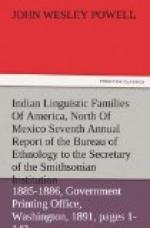The next family name which was applied in this connection is the Skittagets of Gallatin as above cited. This name is given to designate a family on page c, volume II, of Transactions of the Ethnological Society, 1848. In his subsequent list of vocabularies, page 77, he changes his designation to Queen Charlotte Island, placing under this family name the Skittagete tribe. His presentation of the former name of Skittagets in his complete list of families is, however, sufficiently formal to render it valid as a family designation, and it is, therefore, retained for the tribes of the Queen Charlotte Archipelago which have usually been called Haida.
From a comparison of the vocabularies of the Haida language with others of the neighboring Koluschan family, Dr. Franz Boas is inclined to consider that the two are genetically related. The two languages possess a considerable number of words in common, but a more thorough investigation is requisite for the settlement of the question than has yet been given. Pending this the two families are here treated separately.
GEOGRAPHIC DISTRIBUTION.
The tribes of this family occupy Queen Charlotte Islands, Forrester Island to the north of the latter, and the southeastern part of Prince of Wales Island, the latter part having been ascertained by the agents of the Tenth Census.[96]
[Footnote 96: See Petroff map of Alaska, 1880-’81.]
PRINCIPAL TRIBES.
The following is a list of the principal villages:
Haida: Kaigani:
Aseguang. Chatcheeni.
Cumshawa. Clickass.
Kayung. Howakan.
Kung. Quiahanless.
Kun[ch]it.
Shakan.
Massett.
New Gold Harbor.
Skedan.
Skiteiget.
Tanu.
Tartanee.
Uttewas.
Population.—The population of the Haida is 2,500, none of whom are at present under an agent.
TAKILMAN FAMILY.
= Takilma, Gatschet in Mag. Am. Hist., 1882 (Lower Rogue River).
This name was proposed by Mr. Gatschet for a distinct language spoken on the coast of Oregon about the lower Rogue River. Mr. Dorsey obtained a vocabulary in 1884 which he has compared with Athapascan, Kusan, Yakonan, and other languages spoken in the region without finding any marked resemblances. The family is hence admitted provisionally. The language appears to be spoken by but a single tribe, although there is a manuscript vocabulary in the Bureau of Ethnology exhibiting certain differences which may be dialectic.
GEOGRAPHIC DISTRIBUTION.
The Takilma formerly dwelt in villages along upper Rogue River, Oregon, all the latter, with one exception, being on the south side, from Illinois River on the southwest, to Deep Rock, which was nearer the head of the stream. They are now included among the “Rogue River Indians,” and they reside to the number of twenty-seven on the Siletz Reservation, Tillamook County, Oregon, where Dorsey found them in 1884.




